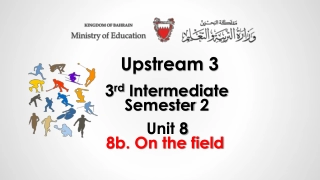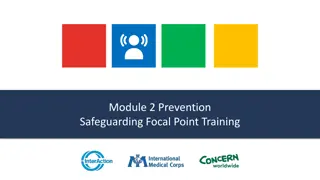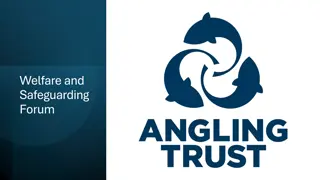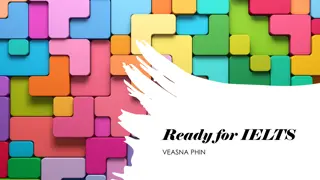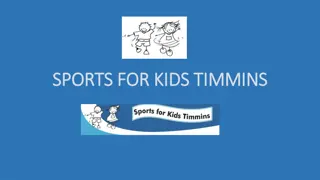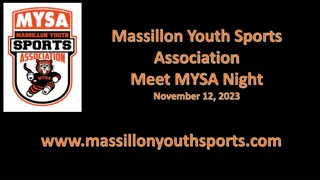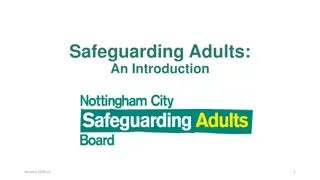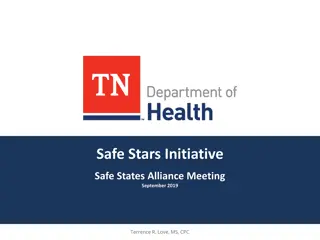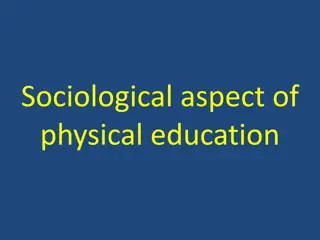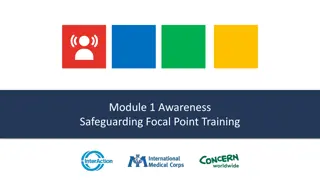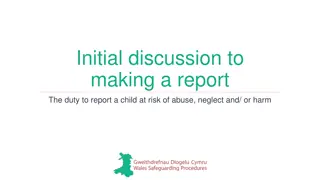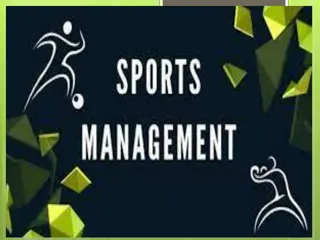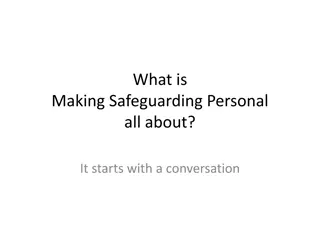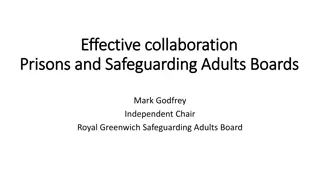
Advancing Safety and Safeguarding in Sports with Project BESST
The Project Building European Safe Sport Together (BESST) focuses on defining transgressive behavior in sports, developing legal frameworks, and providing educational tools to ensure safety at all levels in the sports community. The multi-level approach emphasizes embedding safeguarding practices from international bodies to local sports clubs, coaches, and athletes. By addressing the complex challenges arising when ethics and well-being are compromised, BESST aims to empower a safer future in sports.
Download Presentation

Please find below an Image/Link to download the presentation.
The content on the website is provided AS IS for your information and personal use only. It may not be sold, licensed, or shared on other websites without obtaining consent from the author. If you encounter any issues during the download, it is possible that the publisher has removed the file from their server.
You are allowed to download the files provided on this website for personal or commercial use, subject to the condition that they are used lawfully. All files are the property of their respective owners.
The content on the website is provided AS IS for your information and personal use only. It may not be sold, licensed, or shared on other websites without obtaining consent from the author.
E N D
Presentation Transcript
EMPOWERING A SAFER FUTURE Position paper of project BESST for advancing safety and safeguarding in sports besst-safesport.eu Disclaimer: Funded by the European Union. Views and opinions expressed are however those of the author(s) only and do not necessarily reflect those of the European Union or the European Education and Culture Executive Agency. Neither the European Union nor the granting authority can be held responsible for them.
What is Project BESST? The project Building European Safe Sport Together (BESST) aims: 1 3 To develop a modern definition of transgressive behaviourin sport, with an extensive literature review of the most recent studies. To develop legal frameworks with policies and procedures proposal for European sports organisations. 2 4 To provide an awareness and education tool kit, facilitating the entities to use their communications channels to educate their communities about transgressive behaviour. To assess the statuses level of European sports organisationsand event organisers.
If you ask project BESST partners how we view sports... We will proudly emphasise the bright side: its power to improve lives, build communities and inspire positive change on both individual and societal levels. However, if you were to ask us this question on a deeper level, we would delve into the complex challenge that emerges when the principles of ethics, safety and well-being are compromised and unsafe sports environment arises.
01 Unsafe sports environment is a multi-level challenge in a multi-level system
The sports community is a multi-level system 01 01 Macro Macro level: level: international international International Olympic Committee (IOC), International Sports Federations (IFs) and the United Nations (UN) 2. 2. Macro Macro level: level: continental continental European Olympic Committee (EOC), European Sports Various micro, meso and macro actors contribute to offering the community sports opportunities. In this multi-level system, safeguarding must be embedded in the DNA of every level in the sports community to ensure a safe environment for everyone, regardless of their role (Haandrikman & Schipper-van Veldhoven, 2024). Federations (EFs), ENGSO, and European Union 3. 3. Macro Macro level: level: national national National Olympic Committee (NOC), National Sports Federations (NFs), and governmental institutions (ministries) 4. 4. Meso Meso level: level: local local In particular, the issue is not necessarily specific to sports and may also be an organisational problem. Therefore, a consistent culture of safeguarding should be maintained from top-tier organisations, like the IOC, all the way down to local sports clubs, coaches and athletes. Actors in sports clubs and governmental institutions, and parents 5. 5. Micro Micro level level Athletes and coaches
Despite decades of research The high prevalence of transgressive behaviours among athletes (e.g., Chroni & Fasting, 2009; Hartill et al., 2021; Fasting et al., 2010; Schipper-van Veldhoven et al., 2022), unsafe sports practices continue to exist. Addressing this issue is complex, as it involves a multi-level challenge within a multi-level system, particularly due to the differing roles and responsibilities at each level. However, with every challenge comes a vision....
Project BESST believes that everyone in the sports community should share the vision of a world where sports are entirely safe To realisethis vision, we must align our efforts. Project BESST s vision starts with the basics to tackle this shared multi-level challenge and move towards our collective goal.
02 Foundation for safe(r) sports
To foster a shared responsibility However, not every actor within this community starts from the same position, which impacts their ability to recognise unsafe practices and their capacity to contribute to our collective goal. for ensuring a safe environment in sports, all members of the sports community need to be aligned, as highlighted by Hartill et al. (2021) and Schipper-van Veldhoven et al. (2022).
Awareness through recognition, or the other way around? To address our shared multi-level challenge, it is crucial to focus on both awareness and recognition of unsafe sports practices. However, this presents a chicken-or- the-egg dilemma: which comes first, awareness of unsafe sport practices and transgressive behaviour or their recognition? Project BESST explores this dilemma more deeply by highlightingatwofoldunderlyingissue: No (accurate) understanding and Not (wanting) to see transgressive behaviour and unsafe practices
No (accurate) understanding The need for a consistent definition Varying terminology Cultural differences and inclusion Toemphasisethe need for aconsistent definitionandunderstanding,consider the Furthermore, cultural differences shape the understanding of violence, as certain violent The sports community lacks a universal definition (Kerr et al., 2014) and understanding (Mount- joy, 2020) of term violence as an example. behaviours may be accepted in some unsafe sports practices, which impedes cultures (e.g., hitting a child for pedagogical TheWorldHealthOrganisation (WHO) defines violenceasinvolvingintentional harm(Krug et awareness and recognition of them. reasons). Consequently, using the term violence can hinder the inclusion of all al.,2002).However, this is not always the case forms of unsafe sports practices. This results in varying terminology (e.g., harassment, abuse, in sports. For instance, acoach might subject athletes to excessive drillsthat arephysically inappropriate, intendingtoimprove and violence) with different - linguistic - meanings across academic, performancewithout intendingharm. practical and cultural contexts. Violenceisoften perceivedinterms ofphysicalharmorextreme aggression, which canbemisleading, as this definition istoo narrowlycapturingthefullscope ofunsafe sports practices.
Moving beyond categorisation As our human tendency is to categorise our perceptions to simplify social dynamics to improve our interaction with others, it is no surprise that definitions usually concentrate on categorising specific behaviours. However, categorising behaviours can be challenging, as different forms may interact and overlap (Kerr, 2023). To establish a universal understanding, project BESST moves beyond categorisation and adopts a holistic view by introducing the term transgression to cover various ways of crossing boundaries - be they legal, social, physical, psychological or religious (Madsen, 2014). Based on a comprehensive theoretical framework of project BESST, we propose using the term...
Transgressive behaviour as any form of misuse of a relationship of power violating someone s access to safe sports (Haandrikman & Schipper-van Veldhoven, 2024) To allow a more holistic approach to recognise and become aware of unsafe sports practices and harmful behaviours.
Not (wanting to) see Salience bias Present in sports The focus has shifted from only sexual misconduct to a broader view that People tend to focus more on frequently highlighted issues (Fischer & Engelhardt, This bias is evident in the sports community as well. Unsafe sports practices began to attract attention in encompasses various forms of 2019). In other words, individuals tend to the late 20th century, with academics urging greater transgressive behaviour (Haandrim- kan & prioritise and pay greater attention to awareness (Brackenridge, 2001). This led to some Schipper-van Veldhoven, 2024; Schipper- van Veldhoven, 2017). information that is more prominent and readily noticeable, a cognitive countries revising child protection policies, primarily focusing on sexual harassment and abuse. phenomenon referred to as salience bias (Tversky & Kahneman, 1973). However, Over time, efforts to address transgressive behaviour in sports have expanded to include this tendency may lead to an incomplete or distorted understanding of the broader developing codes of conduct, appointing context. confidants in sports clubs, and launching campaigns by organisations and academics (e.g., Schipper-van Veld- hoven, 2016; Vertommen et al., 2015).
What is not seen does not exist Despite this progress, salience bias continues to affect public perception: people do not see (all of) At the same time, the salience bias affects the effectiveness of preventing transgressive the transgressive behaviours. behaviours in sports, as individuals may assume that what is not seen does not exist . Psychological forms of transgression, in particular, can be more subtle and harder to Therefore, it is crucial to give greater attention to understanding and addressing identify compared to more overt physical transgressions. For example, while the immediate these less salient forms of transgressive effects of physical harm, such as hitting, are (more) easily recognised as wrong, the behaviour to enhance recognition and awareness within the sports community. consequences of psychological transgressions can vary based on factors like intent (accidental vs. non-accidental), context and individual difference.
Not (wanting to) see Case: Case: The The framing framing effect effect People do not always see all forms of transgressive behaviour in sports as equally important due to their varying prominence. Moreover, discussion about these behaviours BESST partners engaged with a key government representative who downplayed transgressive behavior in across countries and cultures, involve more than just variations in terminology. sports, viewing it as a minor concern. As the discussion progressed, partners realized the differing The current incidence and prevalence of transgressive behaviours in sports are framed perspectives stemmed from distinct starting points. While differently across countries, depending on their unique starting points. the representative saw a decline in such behavior compared to decades ago, the partners considered it a pressing issue. At an individual level, the perspective of those experiencing transgressive behaviours in The representative believed the situation would improve sports must be considered to accurately define unwanted behaviour. Beyond more naturally, objective consequences like harm, these transgressions can also lead to subjective outcomes, such as reduced enjoyment of sports or even dropout. which made it seem like the issue was no longer important, though that was not what they actually meant. This However, the organisational level plays a key role in shaping how transgressive behaviours are framed and understood at the individual level. experience highlighted the framing effect, where the presentation of the same information influences how people draw conclusions (Tversky & Kahneman, 1985). It underscores the importance of listening carefully to one another to build safe sports together, focusing on the content of what is being said rather than just how it is framed.
The influence of status Toeffectivelyaddress ourshared multi-level challenge:it iscrucialto furtherexplore the underlyingdynamicsateach levelwithinthesports community. Project BESST examinesthe capacitytocontributetoourcollective goalbyexploringtheinfluence of status withinour multi-level sports community, focusing on two key dynamics: Power & Resources
Truths shaped by power As in society and our sports community, power is seen as crucial for accessing opportunities, creating a hierarchy among individuals and organisations that pressures others to conform to this existing structure. But is this the societal value of power that we want for our sports community? Perceived power Analysing discourses Foucault s philosophy offers a critical lens on Foucault argues that our knowledge of power Stakeholders at all levels within the sports community must be aware of how perceived power* is normalised within structures arises from the way we communicate the sports community, as explored by project and share information, creating a pool of their power dynamics and how they BESST (Haandrikman & Schipper-van Veldhoven, 2024). knowledge where frequently discussed and widely accepted ideas are seen as more valid and true. may be misusing the power that contributes to transgressive behaviours in sports. According to Foucault (1991), power is not something that you just have; it changes and Over time, the ways we talk about these ideas shape shifts based on how people interact with each other. In our sports community, individuals our understanding of what is considered true. To understand the underlying forms and techniques of and organisations often claim to possess (mis)using power, we need to analyse the discourses - power, however, these power structures are how we talk about these so-called truths (e.g., see actually shaped by societal interactions. our report on the Norwegian women s beach handball example).
It is about how these actors are exhibiting power, in what context, over whom, and with what effects
Empowering resources Power and status influence each other and individuals within sports organisations, but resources are crucial for advancing safeguarding efforts. The gap Leadership By doing so, the knowledge and expertise from these resources can Currently, some countries are more advanced in The study of Biedre et al. (2024) also highlighted a safeguarding sports than others, and this gap is significant need for guidance, knowledge and be used more effectively to likely to widen as safeguarding has become an support from both governmental and institutional collaboratively build safe sports additional responsibility for various sports organi- sations (e.g., clubs, national federations, leadership to further advance safeguarding initiatives. Essentially, there should be greater environments by establishing effective systems to connect and and national Olympic committees). Project emphasis on leveraging existing knowledge and empower all levels BESST s study of European National Federations expertise to enhance safeguarding. and National Olympic Committees revealed that human and financial resources are key areas As safeguarding in sports is still in its early stages, it requires more regional and global investment. The that need improvement in safeguarding, sports community should adopt both top-down regardless of their current safeguarding process approaches (e.g., from the IOC to clubs) and bottom- (Bie- dre et al., 2024; 2024b). up approaches, recognising the value of successful initiatives at the meso level of the sports community (Biedre et al., 2024c).
03 Effectively raising the maturity of European sports on its safeguarding readiness
How do we for our shared multi-level challenge of transgressive behaviour in a multi-level system? find Project BESST advocates returning to the fundamentals to effectively enhance the safeguarding maturity of European sports. solutions To this end, we want to emphasise three key messages.
Practice what you preach Advocating for safe sports means ensuring a safe work environment within your own organisations as well. While the focus is often on transgressions between athletes and coaches, this does not fully capture the extent of transgressive behaviours within the broader sports community and among different stakeholders. Anyone can be vulnerable Recently, there have been increasing reports of workplace misconduct at organisational levels (meso and macro) within sports, such as cases involving the director of the Dutch football club Ajax (RTL Nieuws, 2022) and the head of the French Football Federation (Ripley, 2023), as well as persistent toxic workplace cultures worldwide (Whyno & Maaddi, 2022). If you fail to safeguard your own employees or colleagues, ask yourself: How credible is your commitment to safeguarding within the sports community?
Understand power dynamics To align your actions with your values, it is crucial to understand the power dynamics you are part of. Power itself is not inherently negative; its impact depends on how, in what context, over whom, and with what effects it is exercised. Insports, discourses -ways oftalkingandthinking- shapeeverything fromrules andregulations totheidentitiesandbehaviours ofathletes, coaches, andorganisations. Grasping thesediscoursesisessential foraddressingissuesandadvancingsafeguarding. Reflect on whether you areacting basedon perceivedpower orifthepower dynamicshave just shifted. Considerwhat discourses you areperpetuating thatshape andmaintainyour powerdynamic. How can you leverage discourses to influence the practice, perception, and regulation of safe sports, ensuring they reflect and advance broader social norms and safeguarding efforts?
Embrace transformational leadership Building European Safe Sports Together is not a one-person s job; it requires the collective effort of the entire sports community. This means that there is no room for monopolistic control within our community. What we need is transformational leadership - leadership that inspires and motivates others to achieve more than they ever thought possible when it comes to safe sports (Bass & Rigio, 2005). It is about fostering growth, empowering individuals, and helping each other develop into leaders within our respective countries, organisations, and sports communities. By addressing individual needs and empowering those who need support, we can all contribute to the goal we should all share: A world where sports are truly safe for everyone.
References 1. Bass, B. M., & Riggio, R. E. (2005). Transformational leadership. Psychology Press: New York. https://doi.org/10.4324/9781410617095 2. Biedre, I., Campos de Moraes, G., Harada, G., & Negreda, D. (2024a). Building European Safe Sport Together: Assessment of safeguarding status among European National Federations. Project BESST. https://besst-safesport.eu/legal-framework/ 3. Biedre, I., Campos de Moraes, G., Harada, G., & Negreda, D. (2024b). Building European Safe Sport Together: Assessment of safeguarding status among European National Olympic Commitees. Project BESST. https://besst-safesport.eu/legal-framework/ 4. Biedre, I., Campos de Moraes, G., Harada, G., & Negreda, D. (2024c). Safeguarding legal framework for clubs. Building European Safe Sport Together: TBD. Project BESST. https://besst-safesport.eu/legal-framework/ 5. Brackenridge, C. H. (2001). Spoilsports: Understanding and preventing sexual exploitation in sport. Routledge. 6. Chroni, S., & Fasting, K. (2009). Prevalence of male sexual harassment among female sports participants in Greece. Inquiries in Sport & Physical education, 7(3), 288-296. 7. Fasting, K., Brackenridge, C., & Knorre, N. (2010). Performance level and sexual harassment prevalence among female athletes in the Czech Republic. Women in Sport and Physical Activity Journal, 19(1), 26-32. https://doi.org/10.1123/wspaj.19.1.26 8. Fischer, E., & Engelhardt, P. E. (2019). Lingering stereotypes: Salience bias in philosophical argument. Mind & Language, 35(4), 415- 439. https://doi.org/10.1111/mila.12249 9. Foucault, M. (1991). Discipline and punish: The birth of the prison. Penguin Books 10. Haandrikman, M. & Schipper-van Veldhoven, N. (2024). Building European Safe Sport Together: A conceptual framework of transgressive behaviour. Project BESST. https://besst-safesport.eu/safe-sport/ 11. Hartill, M., Rulofs, B., Lang, M., Vertommen, T., Allroggen, M., Cirera, E., Diketmueller, R., Kampen, J., Kohl, A., Martin, M., Nanu, I., Neeten, M., Sage, D., & Stativa, E. (2021). CASES: Child abuse in sport: European statistics - project report. Edge Hill University. 12. Kerr, G. (2023). Gender-based violence in children s sport. Routledge: Taylor & Francis Group. https://library.oapen.org/handle/20.500.12657/58962 13. Kerr, G., Stirling, A., & MacPherson, E. (2014). A critical examination of child protection initiatives in sport contexts. Social Sciences, 3(4), 742-757. https://doi.org/10.3390/socsci3040743 14. Krug, E. G., Dahlberg, L. L., Mercy, J. A., Zwi, A. B., & Lozano, R. (2002). World report on violence and health. World Health Organization.
15. Madsen, O. J., (2014). Transgression. In T. Teo, Encyclopedia of Critical Psychology. Springer. https://doi.org/10.1007/978-1-4614-5583-7 16. Mountjoy, M. (2020). #Time2Act: Harassment and abuse in elite youth sport culture. British Journal of Sports Medicine, 54(7), 367-368. https://doi.org/10.1136/bjsports-2020-101975 17. Ripley, D. (2023). Noel Le Graet resigns as president of the French Football Federation one month following his suspension after alleged sexual harassment claims and phone call rows with Zinedine Zidane. https://www.dailymail.co.uk/sport/football/article-11802049/Noel- Le-Graet- esigns-president-French-Football-Federation.html 18. RTL Nieuws (2022). Geilneef Overmars drong zich op aan vrouwen bij Ajax. https://www.rtlnieuws.nl/nieuws/nederland/artikel/5286611/marc-overmarsnrc-ajax-grensoverschrijdend-gedrag-voetbal-seksueel 19. Schipper-van Veldhoven, N. (2016). Sport en lichamelijke opvoeding in pedagogisch perspectief: Een gouden kans. Lectorale Rede Windesheimreeks Kennis en Onderzoek nr. 60, Zwolle, the Netherlands. 20. Schipper-van Veldhoven, N. (2017). Factsheet seksuele intimidate in de sport. https://www.kennisbanksportenbewegen.nl/? file=7795&m=1496308966&actionfile.download 21. Schipper-van Veldhoven, N., Mulder, J., Cuelenaere, B., Zandvliet, R., Farzan, K., & Reijnen, M. (2022). Transgressive behaviour in Dutch youth sport. Social Sciences, 11(8). https://doi.org/10.3390/socsci11080348 22. Tversky, A., & Kahneman, D. (1973). Availability: a heuristic for judging frequency and probability. Cognitive Psychology, 5(2), 207-232. 23. https://doi.org/10.1016/0010-0285(7)90033-9 24. Tversky, A., & Kahneman, D. (1985). The framing of decisions and the psychology of choice. Behavioural Decision Making, 25-41. https://doi.org/10.1007/978-1-4613-2391-4_2 25. Vertommen, T., Schipper-van Veldhoven, N., Hartill, M., van den Eede, F. (2015). Sexual harassment and abuse in sport: The NOC*NSF helpline. International Review of the Sociology of Sport, 50(7), 822-839. https://doi.org/10.1177/1012690213498079 26. Whyno, S., & Maaddi, R. (2022). House report: Dan Snyder had role in toxic Commanders culture. https://www.cbc.ca/sports/football/nfl/washington-commanders-snyder-rol-in-toxic-culture.16679678

